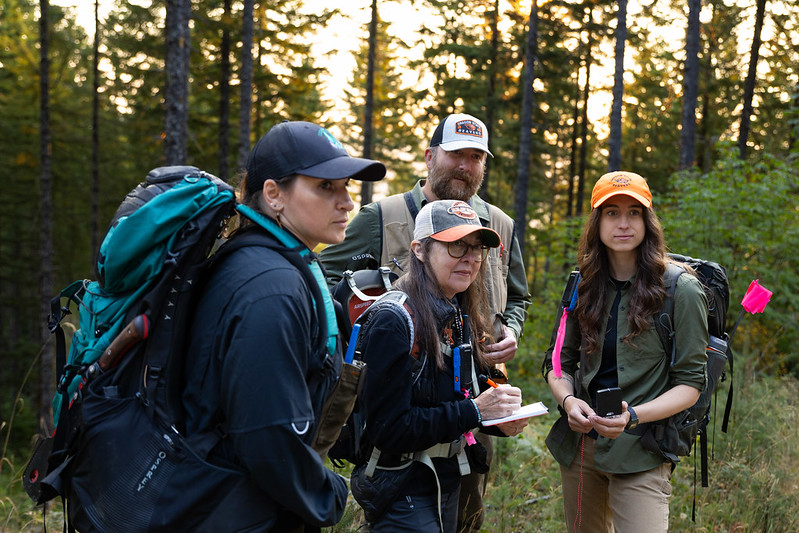
Two Oregon State University faculty are among the lead authors of a that combines Indigenous Knowledge and western science for the purpose of informing future climate-adapted land management decisions across the United States.
The authors say their recommendations include “practical and cultural management interventions that could help avert the loss of thousands of acres of old-growth forest.”
The report, co-led by Cristina Eisenberg and Michael Paul Nelson of OSU and fire ecologists Susan Prichard of the University of Washington and Paul Hessburg of the U.S. Forest Service’s Pacific Northwest Research Station, urges that Tribal stewardship practices such as thinning and burning be considered in future land management decisions by the U.S. Forest Service.
The Forest Service had expressed interest in gaining a better understanding of the connection between Indigenous Knowledge and western science in land management planning.
“Our forests are in grave danger in the face of climate change,” said Eisenberg, the College of Forestry’s associate dean of inclusive excellence. “By braiding together Indigenous Knowledge with western science, we can view the problems with what is known as Two Eyed Seeing, to develop a path forward that makes our forests more resilient to the threats they are facing. That is what this report is working to accomplish.”
Eisenberg, who is Native American, is the Maybelle Clark Macdonald Director of Tribal Initiatives for the college and Nelson is a professor of environmental philosophy and ethics.
Eisenberg, Prichard, Nelson and Hessburg guided an interdisciplinary team of more than 40 scholars and practitioners in producing “Braiding Indigenous Knowledge and Western Science for Climate-Adapted Forests: An Ecocultural State of Science Report.”
“Climate change is stressing these forests even as they are considered for their potential role in slowing rates of climate change,” Prichard said. “We want this report to provide not just guidance, but also hope – hope in the practical measures we can take now to promote resiliency and help forests thrive.”
The document recommends different forest management approaches depending on the region and is responsive to President Biden’s April 2022 executive order 14072, “Strengthening the Nation’s Forests, Communities and Local Economies.”
“We are very interested in understanding how Indigenous Knowledge can be used in combination with western science to improve our management of all forest conditions including old growth,” Forest Service Deputy Chief Chris French said. “This report is a big step in improving our understanding of how to do that.”
French added that the Forest Service values knowledge, input and learning from the Tribal community. The agency requested the help of OSU to host a series of roundtables to begin the process of gathering information from Tribal experts on initiating the co-stewardship described in the report, which recommends:
- Prioritizing restoration through active management, including thinning and cultural and prescribed burning, in national forest units that are at the highest risk for wildfire.
- Recognizing and respecting Tribal sovereignty and Indigenous Knowledge, and honoring the ethics of reciprocity and responsibility to future generations.
- Allowing flexibility to ensure management strategies can be modified to accommodate diversity of landscapes across national forests, as well as the rapidly evolving impacts of climate change.
- Researching and monitoring adaptive stewardship approaches to help land managers learn from and adjust strategies based on what works best for local conditions.
“Our report is deeper than changes in policy and management – it proposes a fundamental change in the worldview guiding our current practices,” Nelson said. “Our writing team’s cultural, geographic and disciplinary diversity allows for guidance on a shift in paradigms around how we approach forest stewardship in the face of climate change.”
The report’s authors say that to help ensure the resiliency of North America’s mature and old-growth forests, changes in management, and the thinking that underpins policies and practices, are needed.
They note that federal policy, including the Infrastructure Investment and Jobs Act, contains direction to weave Indigenous Knowledge with western science while supporting treaty rights, advancing co-stewardship and promoting cultural practices into land management decision making.
“The future of our forests is dependent upon a new way of thinking in how we have conserved, managed and stewarded forests in North America,” said co-author Tom DeLuca, dean of the OSU College of Forestry. “The recommendations in this report are one step in the direction of how we are evolving forest management and stewardship toward greater climate resilience.”
Forest threats include wildfire, heat stress, drought, pathogen and insect outbreaks, rapid development and invasive species, the authors note. Those threats combine to degrade habitat as well as lower the forests’ economic and cultural value.
Represented on the core writing team are Tribal members and Forest Service personnel as well as faculty from North Carolina State University, the University of Missouri, the University of Idaho, the University of Minnesota, the University of Arizona, the University of California and Universidad Nacional Autónoma de México.
“Two powerful ideas we heard from our Indigenous colleagues in developing this are those of reciprocity and the seven generations principle. Collectively, the writing team agrees that we can frame a more sustainable land ethic with these ideas,” said Hessburg. “These perspectives guided our recommendations, which suggest taking from the land and giving back in equal measure, and proactively stewarding these lands with seven generations in mind.”
In addition to the Forest Service, the report’s other funders are the Resources Legacy Fund, the 444S Foundation, the Doris Duke Charitable Foundation, the Gordon and Betty Moore Foundation and the Wilburforce Foundation.
